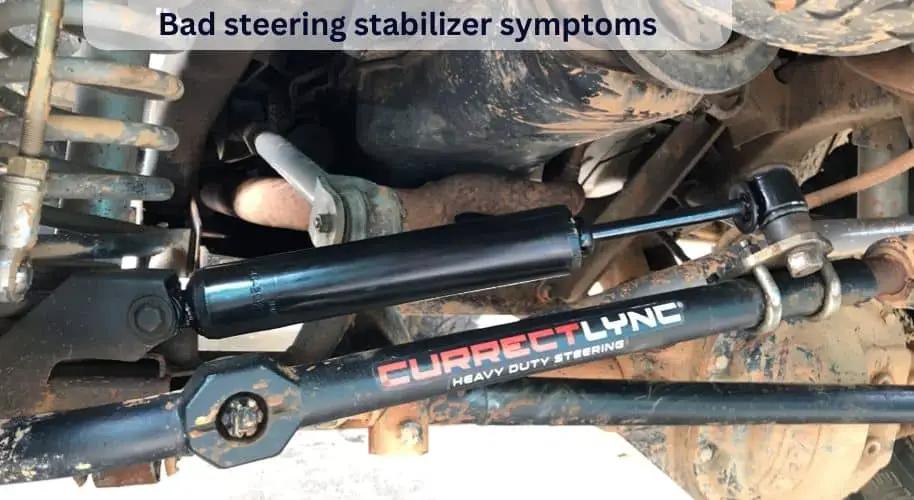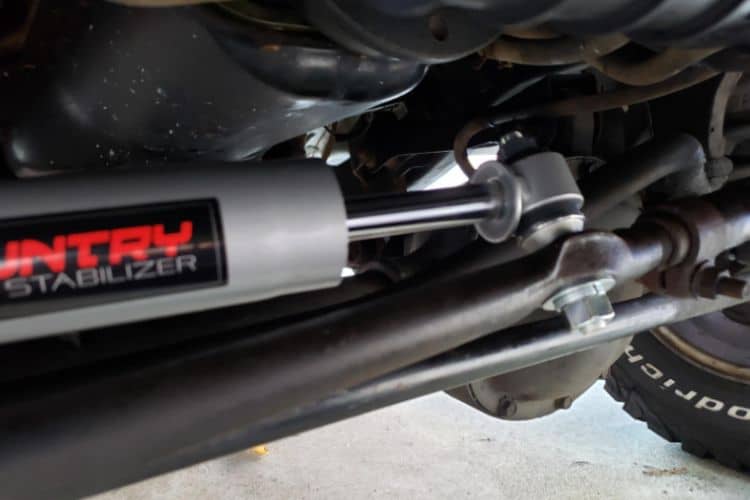Last Updated on March 14, 2023 by Henry T. Hawkins
The steering stabilizer is a crucial component of your car’s suspension system and helps dampen road conditions’ effects on your vehicle’s steering.
If it starts to malfunction, you may experience various symptoms ranging from mildly annoying to potentially dangerous.
In this article, we will discuss the common symptoms of a bad steering stabilizer and what you should do if you suspect that your car has one. So, keep reading!

- Bad steering stabilizer symptoms
- Watch this video – How To Tell If A Steering Stabilizer Is Bad
- Can you drive with a bad steering stabilizer?
- How do I test my steering stabilizer?
- How long do steering stabilizers last?
- Can you drive without a steering stabilizer?
- What will a new steering stabilizer do?
- Do I need two steering stabilizers?
- Wrapping Up
Bad steering stabilizer symptoms
Here are some of the common signs that you have a bad steering stabilizer:
Shaking or wobbling of the steering wheel
If you feel your steering wheel shaking or wobbling, this could indicate that your steering stabilizer is failing. Faulty seals are the most common issue that arises from a damaged steering stabilizer stop.
These seals contain pressurized fluid, which allows the stabilizer to do its job. However, when these seals fail, it can cause the tires and wheels to overload the suspension and create an unpleasant shaking sensation in the steering wheel.
This vibration will usually be noticeable at slow speeds and worsen as speed increases, whereas tire imbalance issues tend to only showcase themselves at higher rates of speed.
If you experience shaking when accelerating, stop the vehicle and inspect the front suspension for fluid sprayed under the hood.
This is usually a sign that the seals in your steering stabilizer have popped and require immediate replacement to prevent further issues. An ASE-certified mechanic should be able to take care of this quickly and efficiently. Don’t delay – get it done right away!
Loose Steering Feel
If you experience a lack of control when steering your truck, it may indicate that the steering stabilizer stops are wearing out or leaking fluid.
The steering wheel will feel loose, and you may feel like the truck is floating on the road rather than responding to your manual input.
It is possible to repair the worn seal in some cases but it is generally recommended to replace both sides of the steering stabilizer stop on the same axle for optimal performance.
Doing both sides at once ensures equal balance and effectiveness from each side. If you notice any wear or damage to your vehicle’s steering stabilizers, always address them promptly to ensure safety and optimal driving conditions.
Driving can be jerky due to choppy steering
Driving can be uncomfortable due to choppy steering. This is caused by a broken steering stabilizer stop which allows for more travel in the suspension system, leading to a shaking motion in the steering wheel.
To fix this issue, have your mechanic replace the steering stabilizer stop with a new unit and have them align the front-end suspension for optimal tire wear.
Doing so should restore smooth driving conditions and make your car feel like new again.
The car veers to one side when driving over bumps
If your car veers to one side when driving over bumps, this is a sign that the steering stabilizer stops are worn out and need replacing. A worn-out suspension system will not provide enough resistance to changing roadways and can cause instability while driving.
It is best to have your mechanic inspect the steering stabilizer stops for wear or damage and replace them if necessary. Doing this will help ensure a smooth ride and improved safety while on the road.
Noises when turning sharply
If you hear creaking or groaning noises coming from the front end of your vehicle when making sharp turns, it could indicate that your steering stabilizer stops are failing.
This happens because as the stabilizers wear out, the suspension will have more play, allowing for more movement and noise when turning.
The steering feels vague or hard to turn
If you find that it is becoming increasingly difficult to turn your steering wheel or you feel like your car isn’t responding correctly, this could mean that the steering stabilizer stops are worn out.
These are just some of the signs that you should look out for when inspecting your steering stabilizer stops. Taking care of your car’s suspension system is essential for keeping you and your passengers safe on the road.
Also read: Can you reuse a donut spare
Watch this video – How To Tell If A Steering Stabilizer Is Bad
Can you drive with a bad steering stabilizer?
Yes, it is possible to drive with a bad steering stabilizer, also known as a steering damper. Its function is not to stabilize the steering system but to protect it from shock and impact when encountering bumps or dips in the road.
So, you can drive with a bad steering stabilizer, although it would be best to replace it if you can.
You should note that a bad steering stabilizer can lead to increased wear and tear on the suspension components and reduced vehicle handling and control.
So, we recommend replacing a worn or damaged steering stabilizer to ensure safer driving conditions.
“Without a stabilizer, your steering system can become worn out much faster as it is constantly fighting against the bumps and dips of uneven terrain,” Andrew Waits, race car mechanic at Scrappers Racing. “It’s also important to remember that a bad stabilizer allows vibrations to travel through steering components, leading to premature wear and tear.”
Also read: Can you polish and wax vinyl wrap
How do I test my steering stabilizer?
Testing your steering stabilizer is an important step to ensure your car remains safe and roadworthy. Here are the steps you should take:
- Before starting the test, check that your steering wheel is centered on straight roads and when turning left and right.
- Drive in a straight line at a steady speed of no more than 15 mph and hold the steering wheel in the same position throughout the entire test.
- If your car begins to drift away from a straight line during the test, it indicates that your stabilizer needs some attention or replacement.
- Take your car to a qualified mechanic for further inspection and repairs if necessary.
These are the few ways you can test whether your steering stabilizer is working as it should. It’s best to get your car checked regularly to ensure that all its components are in good working order.
Regular servicing and preventive maintenance can go a long way toward keeping your car safe and roadworthy for many years to come!
How long do steering stabilizers last?

There is no specific lifespan for these parts, but they are not known for longevity and are considered routine maintenance items. If you have large wheels and tires installed or regularly take your vehicle off-road, you may need to replace the stabilizer more frequently.
However, with proper care and maintenance, your steering stabilizer should be able to provide improved handling for your entire vehicle’s lifetime.
If you want to ensure maximum efficiency from your steering stabilizer, you should regularly inspect the parts and check for signs of wear and tear or damage.
Can you drive without a steering stabilizer?
Yes, you can drive without a steering stabilizer. As mentioned above, a steering stabilizer is designed to isolate and protect the driver from any sudden jerks or vibrations while driving.
While it is not necessary to have one installed to drive safely, some drivers may experience increased vibration or wobble if they do not have one installed.
However, you should ensure that all other components of your vehicle’s suspension system are in good condition before deciding whether or not to install a steering stabilizer.
If everything else is in good working order, then you should be able to drive without a steering stabilizer without any issues.
Also read: Can a bad oil pressure sensor cause damage to engine
What will a new steering stabilizer do?
A new steering stabilizer can improve handling and smoother ride quality, helping to make your car feel more responsive. It can reduce road shock, minimize body roll and improve cornering grip.
It can also help balance a turning vehicle’s forces, providing better control in sharp turns.
Additionally, a steering stabilizer can help minimize driver fatigue by reducing the effort required to turn the wheels.
Most importantly, it can help extend the life of your tires by preventing wear and tear caused by uneven road surfaces.
Do I need two steering stabilizers?
Steering stabilizers can help reduce the swaying and shimmying of your vehicle due to rough terrain. If you have a lifted vehicle, larger tires, or drag racing applications, you may benefit from installing two steering stabilizers to improve the performance of your steering system.
Also, a single stabilizer should do the trick if your vehicle is faintly vibrating.
However, if you often go on rugged off-roading excursions or attach massive accessories like winches and snow plows to your truck, then investing in a dual steering stabilizer would benefit you.
So, it comes down to your driving experience and preferences. If you feel satisfied with the performance of a single stabilizer, then that should be enough, but if you need extra protection, then a dual steering stabilizer setup can be the way to go.
Wrapping Up
Thanks for reading this guide on bad steering stabilizer symptoms. We hope that you understand better how to identify if your steering stabilizer stops are worn out and what needs to be done to ensure optimal performance.
Remember, if you experience any of these issues, it is best to get them checked out immediately by an ASE-certified mechanic.
Taking the proper steps now can help avoid costly repairs down the line and keep you safe on the road.
Please share this guide if you found it helpful!
Sources:
- https://www.youtube.com/watch?v=fZFujkaQoLU
- https://tonybassogm.com/parts/suspension/myths-and-truths-about-steering-stabilizers-can-you
